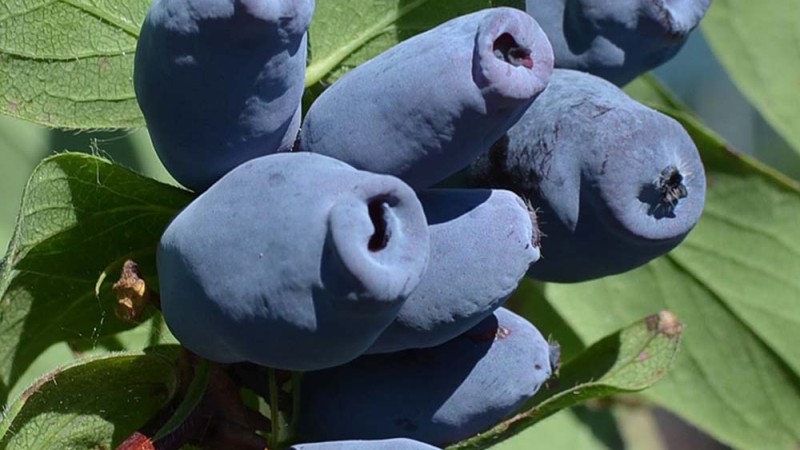
Bakčarská šľachtiteľská stanica obhospodaruje najväčšiu plantáž zemolezu (Lonicera caerulea) na Sibíri. Zaberá plochu viac ako 50 hektárov lokalizovaných v severnej oblasti regiónu Tomsk. Väčšinu tejto plochy tvoria selekčné sady a pozemky, na ktorých je sústredený genetický materiál pre porovnávacie štúdie. Za celú tú dobu práce so zemolezom, bolo vykonaných nespočetné množstvo krížení, vysadených a posúdených viac ako 45 000 hybridných semenáčov.
Začiatky šľachtiteľskej práce siahajú do roku 1964, keď pracovníci šľachtiteľskej stanice I.K. Gidzjuk na Kamčatke a Z.P. Žolobová v Západnej Sibíri zozbierali semená divých foriem zemolezu. Po ich výseve sa ukázalo sa že spomedzi všetkých, len poddruhy Lonicera Kamtschatica, Lonicera Turczaninowii a Lonicera Altaica poskytovali pri vzájomnej hybridizácii relevantné výsledky. Teda hybridné formy s veľkými a veľmi veľkými, sladkými plodmi bez horkosti, ktoré pri dozretí neopadávajú z kríka. Zároveň odolné voči suchu, primerane úrodné a vhodné pre prípadný mechanizovaný zber.
Dnes tvorí genofond 13 500 sadeníc, zbierka obsahuje 60 odrôd a na pozemkoch porovnávacích štúdií je ďalších 190 odrôd. Na komerčné pestovanie a mechanizovaný zber sa skúša 22 vybraných odrôd z miestnej selekcie. V severnej zóne Tomskej oblasti sa testuje správanie 21 zahraničných odrôd. Prvé odrody zemolezu boli vytvorené práve tu, sú to Tomička a Bakčarskaja, ktoré sú zapísané v Štátnom odrodovom registri od roku 1987.
Šľachtitelia z Bakčara doteraz vyšľachtili 25 pôvodných odrôd zemolezu. 19 z nich je zapísaných do Štátneho odrodového registra. Sú to: Tomička, Bakčarskaja, Kamčadalka, Vasjuganskaja, Roksana, Narymskaja, Sibirjačka, Gordosť Bakčara, Pamjati Gidzjuka, Bakčarskij Velikan, Parabeľskaja, Čulymskaja, Siľginka, Bakčarskaja Jubilejnaja, Streževčanka, Doč Velikana, Jugana, Ussuľga a Vostorg. Pre desať z nich boli udelené patenty na právnu ochranu odrôd a autorské osvedčenia. V posledných rokoch bolo vytvorených niekoľko nových odrôd - Sinij Utes, Sinij Šarik, Lavina, Uslada, Mamontenok a Akvamarin. Všetky sa v súčasnosti testujú v štátnych odrodových skúškach v Západosibírskom regióne. Nové odrody boli postupne úspešne otestované v chladných regiónoch Novosibirsk, Altaj, Krasnojarsk, Burjatsko, Amur, Tjumen a urýchlene sa začalo s ich množením. Každý rok sa vypestuje a predá približne 200 tisíc sadeníc nových odrôd zemolezu.
Skoré odrody v strednom Rusku dozrievajú na začiatku júna. V miernych klimatických pásmach si môžete plody vychutnať už v máji. A v chladnejších oblastiach sa zber začína v posledných júnových dňoch. Pre lepší výnos sa vysádza niekoľko rôznych odrôd s rovnakým obdobím kvitnutia. Zemolezy sú vysoko mrazuvzdorné, znesú aj 50-stupňové mrazy!
Zemolezy začali získavať na popularite s vyšľachtením nových vynikajúcich bakčarských odrôd z Tomskej oblasti. Mnohé sa vyznačujú sladkosťou, veľkosťou plodov, vysokým výnosom a vhodnosťou na mechanizovaný zber. Tu je bližší prehľad najlepších odrôd zemolezu z hľadiska chuťových vlastností:
Sibirjačka - skorá odroda s rovnomerným dozrievaním sladkých aromatických bobúľ. Z 10-ročnej rastliny sa zberajú 2 kilogramy fialových, vretenovito tvarovaných, malých plodov. Maximálny výnos z jedného kríka je 3,2-3,5 kg plodov. Keď prezrejú, prakticky neopadávajú, naopak, pevne držia na konároch. Jej výhody sú zimná odolnosť do -50 °С, odolnosť voči suchému počasiu, škodcom a chorobám. Najlepšie opeľovače sú Kamčadalka, Tomička a Pamjati Gidzjuka.
Sinij Utes - nová, vysoko úrodná odroda zapísaná do Štátneho odrodového registra pre Západosibírsky región. Bobule dozrievajú od 10. do 20. júna. Vážia v priemere 1,6 g. Dužina je sladkokyslá s obsahom cukru 9,8 %. Výnos z kríkov vo veku 7-8 rokov je približne 4 kg neopadajúceho ovocia. Odroda s vyznačuje sa vysokou mrazuvzdornosťou a dobrou odolnosťou voči škodcom a chorobám. Je stredne odolná voči suchu a teplu. Vhodné opeľovače sú Ussuľga a Vostorg.
Siľginka - je považovaná za jeden z najchutnejších zemolezov. Odroda má aromatické bobule s jemnou dužinou a priemernou hmotnosťou 1,4 g až 2,2 g. Výnos z jedného kríka je 3,5 kg. Začína plodiť v druhom alebo treťom roku po výsadbe. Ker nepresahuje 1,5 metra na výšku a 1,20 metra na šírku. Koruna je oválna, nie veľmi hustá. Odroda je samoopelivá, ale produkuje viac plodov, keď sa pestuje spolu s inými odrodami.
Bakčarskij Velikan - populárna odroda, ktorej charakteristickým znakom sú veľké plody valcovitého tvaru a vysoká produktivita. Hmotnosť každého plodu môže dosiahnuť 2,5 g. Bobule majú osviežujúcu sladko-kyslú chuť. Prvú úrodu je možné zbierať do dvoch až štyroch rokov po výsadbe. Prináša pravidelné úrody až dve desaťročia, pričom z každého kríka nazbierame 3 – 4,8 kg šťavnatých bobúľ. Na krížové opeľovanie sú potrebné odrody s rovnakým obdobím kvitnutia. Ker dorastá do výšky 2 metre, je odolný voči chorobám, škodcom a silným mrazom.
Doč Velikana - bobule tohto hybridu sa považujú za jedny z najväčších. Plody sú hruškovitého tvaru, takmer čiernej farby a vážia až 2,5 gramu. Vyznačujú sa svojou sladkosťou, len miernou kyslosťou, bez náznaku horkosti. Výnos je približne 3-3,5 kilogramu z jedného kríka. Plody pevne držia na vetvách. Je to stredne skorá odroda, plody dozrievajú v druhej polovici júna. Spočiatku rastie pomaly a komerčný výnos vykazuje až päť až šesť rokov po výsadbe. Krík je veľký, s pomerne hustou korunou. Pre dobrú úrodu sú potrebné opeľovače.
Uslada - nová odroda uvedená na trh v roku 2023 s vynikajúcimi vlastnosťami. Plody sú veľmi veľké, s hmotnosťou od 1,7 do 3,5 g, tmavo fialové v tvare širokého vretena s hrubou šupkou. Ich chuť je vysoko hodnotená, príjemná a aromatická, niet divu, že sa volá Uslada (Potešenie). Plody dozrievajú koncom júna, neopadávajú a ľahko sa prepravujú. Kríky prinášajú pravidelné každoročne vysoké úrody. Výnos z 8-10 ročnej rastliny je až 4 kg plodov. Táto odroda je vysoko odolná voči chorobám a škodcom a znesie teploty pod -40 °С. Jej odolnosť voči horúcemu a suchému počasiu je však priemerná. Na opeľovanie sú vhodné stredne neskoré odrody, napríklad Bakčarskaja Jubilejnaja.










